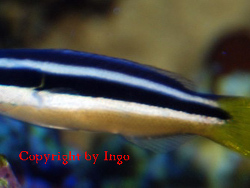Info
(Bleeker, 1856)
Occurs in coral rich areas of shallow lagoons and sheltered seaward reefs. Adults feed mainly on coral polyps while juveniles remove ectoparasites from small territorial fishes.
Synonym:
Labroides xanthurus Bleeker, 1856
Classification: Biota > Animalia (Kingdom) > Chordata (Phylum) > Vertebrata (Subphylum) > Gnathostomata (Superclass) > Pisces (Superclass) > Actinopteri (Class) > Perciformes (Order) > Labroidei (Suborder) > Labridae (Family) > Diproctacanthus (Genus) > Diproctacanthus xanthurus (Species)
Jumping guard
A jumping guard prevents (nocturnal) fish from jumping out.
Wrasses, blennies, hawkfishs and gobies jump out of an unprotected tank in fright if their night rest is disturbed, unfortunately these jumpers are found dried up in the morning on carpets, glass edges or later behind the tank.
https://www.korallenriff.de/en/article/1925_5_Jump_Protection_Solutions_for_Fish_in_the_Aquarium__5_Net_Covers.html
A small night light also helps, as it provides the fish with a means of orientation in the dark!
Occurs in coral rich areas of shallow lagoons and sheltered seaward reefs. Adults feed mainly on coral polyps while juveniles remove ectoparasites from small territorial fishes.
Synonym:
Labroides xanthurus Bleeker, 1856
Classification: Biota > Animalia (Kingdom) > Chordata (Phylum) > Vertebrata (Subphylum) > Gnathostomata (Superclass) > Pisces (Superclass) > Actinopteri (Class) > Perciformes (Order) > Labroidei (Suborder) > Labridae (Family) > Diproctacanthus (Genus) > Diproctacanthus xanthurus (Species)
Jumping guard
A jumping guard prevents (nocturnal) fish from jumping out.
Wrasses, blennies, hawkfishs and gobies jump out of an unprotected tank in fright if their night rest is disturbed, unfortunately these jumpers are found dried up in the morning on carpets, glass edges or later behind the tank.
https://www.korallenriff.de/en/article/1925_5_Jump_Protection_Solutions_for_Fish_in_the_Aquarium__5_Net_Covers.html
A small night light also helps, as it provides the fish with a means of orientation in the dark!







 robertbaur
robertbaur







